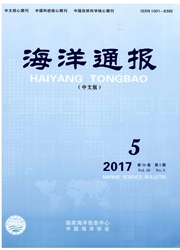

 中文摘要:
中文摘要:
长江水下三角洲层序地层学研究有助于全面了解长江三角洲地层特征和沉积环境演化模式。通过对长江水下三角洲下切河谷区YD0901和YD0903孔岩心的详细沉积物粒度、特征元素比值(Cl/Ti和Zr/Rb)、沉积相对比分析,恢复了冰后期以来长江水下三角洲层序地层格架。研究区冰后期以来自下而上依次出现河流相、潮汐河流相、河口湾相、浅海相和三角洲相的沉积相序。末次冰期海平面下降,古长江形成下切河谷,古河间地发育硬黏土层,构成五级Ⅰ型层序界面。之后海平面回升,分别于15 cal ka BP和8.0 cal ka BP形成最大海退和最大海侵界面,水下三角洲区域最大海侵发生时间略滞后于平原区,约为7.5 cal ka BP。据此3个层序界面将冰后期地层划分为低位体系域、海侵体系域和高位体系域。钻孔岩心记录揭示了14.8 cal ka BP海侵到达研究区;14.8-13 cal ka BP期间,受MWP-1A冰融水事件影响海平面快速上升,海岸线向陆推进速率可达71.9km/ka;海退期间各钻孔沉积速率较低,直至2 cal ka BP开始,沉积速率明显增加。
 英文摘要:
英文摘要:
Sequence stratigraphic research of the Yangtze River subaqueous delta is conducive to a comprehensive understanding of the Yangtze River delta stratigraphic characteristics and sedimentary environment evolution model. Detailed analyses of grain-size compositions,sedimentary facies and elemental ratios(Cl/Ti、Zr/Rb)of cores from Boreholes YD0901 and YD0903 located at the Yangtze paleo-incised valley establish the postglacial period high-resolution stratigraphic framework of the Yangtze River subaqueous delta.The postglacial facies associations in the Yangtze River delta(YRD)are vertically stacked from fluvial facies at the bottom,through tidal-river facies,estuarine facies,and shallow-marine facies,to deltaic facies at the top. Since the Last Glacial period sea-level began to decline,and the incised valley of ancient Yangtze River developed. Stiff clay on the interfluve of the incised valley constitutes the Ⅰ-type sequence boundary. After then the sea-level began to rise,the regression and transgression reached its maximum in 15 cal ka BP and 8.0 cal ka BP respectively,and the time of maximum transgression at subaqueous delta slightly lagged behind the plain area which is about 7.5 cal ka BP. According to these three sequence boundaries,the strata were divided into lowstand system tracts(LST),transgressive system tracts(TST)and highstand system tracts(HST). Based on AMS14C dating results,post-LGM (Last Glacial Maximum)transgression reached the coring area roughly in 14.8 cal ka BP. The rate of shoreline retreatment was up to 71.9,km/ka,resulting from rapid sea-level rise by the MWP(Meltwater Pulse)-1A event in 14.8-13cal ka BP. In the early regression period,the deposition rate of the boreholes was low. It increased significantly since 2 cal ka BP.
 同期刊论文项目
同期刊论文项目
 同项目期刊论文
同项目期刊论文
 期刊信息
期刊信息
